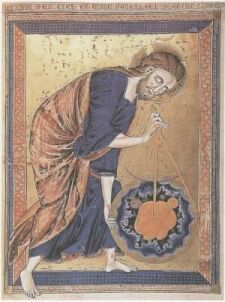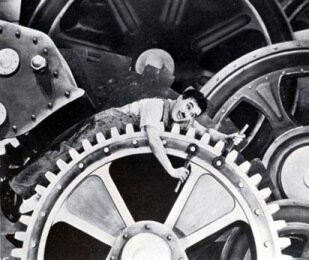Order from Disorder.
Creation in Everyday Life.
A commonly-heard assertion from evolution-deniers is "order cannot arise from disorder", confidently offered as if it were a principle or law of nature. Though this idea has considerable emotional appeal to those with little understanding of science, it has no support in science, and abundant evidence observable today clearly shows that it is simply not true as a general principle.

|
Evolution in your pocket.
Scientists often wear lab coats, because they have handy pockets for pencils, note pads, and other necessities. Mine usually has paper clips and rubber bands in the pockets, as well as other assorted junk. But when one fishes into the pocket for a rubber band, you often find that the bands, which were once separate, have organized themselves into a tight little ball. The picture shows the most recent example from my pocket.
It's just one more example, among many, of order arising from disorder without purposeful design. Not a "big deal" by itself, but at least it is one you can put to the test yourself. The bands were separate, but by constant agitation they end up into a little "rubber band atom". No one intended or planned that result. Rubber bands were not "designed" to do this. It happens naturally, a result of the properties of the rubber bands, and certain physical laws of friction.
You often hear some folks say "Order cannot arise from disorder" and "Design requires a designer who purposefully intended that designed result." These are but empty slogans with no scientific content or validity. Yet these few puerile assertions represent the whole content of the currently fashionable "Intelligent Design" (ID) being aggressively promoted by those who would like to put their God into the science curriculum of the public schools.
ID has no scientific credibility whatsoever, and wouldn't even attract the notice of scientists were it not for the threat that, if it were to prevail in the schools, it would compromise and corrupt science education. As a philosophical notion, it doesn't attract much interest amongst philosophers either. Why? Because as a scientific proposition, there's not the slightest evidence for it, and it is untestable and unfalsifiable. As a philosophical proposition, it is completely empty of content.
Testimony of the stones.

|
When I was growing up on a farm in Iowa, we had country roads that were surfaced with crushed limestone. These developed ruts from traffic, especially near abrupt curves where cars had to brake to slow down. The ruts were shallow at first but got rougher and deeper with time, and had a characteristic spacing. From time to time maintenance crews would use a grader with a blade to smooth the surface, but with time the ruts would form again, just as before.
The graded road surface has a "random" distribution of stones of various sizes, what we call a "disordered" condition. The rutted road has ordered structure of equally spaced alternating regions of loose stones, and hard subsurface below. The picture, taken in 2005, shows a recent example.
Order has arisen from disorder. The orderly pattern of ruts is an example of what some would call "design". Yet it didn't have a designer. Certainly the folks who crushed the stone for the road didn't have this outcome in mind. The people who designed automobiles and their suspension systems didn't plan this outcome, and if they could have done so they would likely have wished to design the automobile to prevent it.
A similar rut formation occurs on asphalt roadways near stop signs, when the asphalt coating isn't thick enough, or the road bed not properly laid down. This happens especially in warm weather on roads that have been surfaced and resurfaced a number of times without reconstructing the underlying roadbed.

|
Evolution under your bed.
Consider the lowly dust bunny. Fibers from blankets fall to the bedroom floor, and circulating air moves them around so that they congregate in places where the air is calmest. In the process they combine and cling together into little fuzzy clumps we call "dust bunnies." Once formed, they persist, until swallowed up by a vacuum cleaner. (However it is not true that they mate and reproduce, as some claim.) This is another everyday example of a stable, ordered structure arising from disordered raw materials by the action of purposeless and chaotic natural processes.
Sorting order from disorder.
Similar processes have practical uses in industry. Consider a factory that makes small plastic parts of rather complex shape, and needs to place them on an assembly line conveyor belt in the proper orientation. One way to do this is to dump the parts into a large container. The container continually vibrates and agitates them. They move about in a chaotic jumble. But at one side is a shaped exit chute. When a part just happens to reach the chute correctly oriented, it can pass through, otherwise it cannot. The parts emerge all properly ordered and oriented. Order arose from disorder through chaotic movement. Now in this case, those who wish to preserve their notion of "design requiring a designer" can argue that the container and chute were "designed" to achieve this particular result for these particular shapes. That's a bit disingenuous, for the machine is actually exploiting the fact that order can arise from disorder. We've just facilitated the process. One could imagine some naive engineer, fresh from university courses in robotics and computer control, trying to make a robotic machine that would examine each piece, pick it up, then rotate it to the correct orientation and place it on the conveyor. That's what is called in engineering "using a sledgehammer to crack a walnut".
Other examples of natural processes that produce order from disorder are: ocean waves, sand dunes, wind-produced sand ripples (see photo), the formation of crystals from solution, and, of course, snowflakes.
Stable structures from disordered parts.
 |
| Paper clips caught in the act of creation of a linked, stable structure. |
|---|
Some say, "Sure, patterns and order can be the result of disordered raw materials and events. But how about stable structures?"
What office worker has not occasionally found linked paper clips, even in a brand new shrink-wrapped box of clips? "Oh, just someone at the factory playing a prank," we assume. Not necessarily. In today's automated factories that's rather unlikely. It's more likely that the clips linked themselves due to jostling chaotic mixing during manufacture or shipping.
I asked our department secretary for all the new boxes of paperclips in the storage closet. As usual, she thought I was daft. I told her it was time for the annual paper-clip inspection. I fully expected to have to look through many boxes to find anything suggestive of linking. Each box had 100 paperclips and all boxes were in an unopened shrink-wrapped factory packaging. Actually, in the second box I found the example in the center of the picture above. Paper clips caught in the act of creation of a bonded pair! Finally in the tenth box I found a linked pair, seen at the right.
Now consider the sequence of events required to bring this about. First, two clips need to fall into correct initial position, and then receive a jolt, in just the right way, to force part of one clip into the space between two wires, forcing the wires apart against their springiness. Then successive jolts, which could work for or against linking, must occur, and there must be more that favor linking. Once linked, the system is much more stable, and would require far more agitation, and/or more energy, to unlink. Indeed, the shape of the clips (their geometry) strongly biases against unlinking.
An interesting experiment: Put a handful of paper clips in a small rock tumbler and let it run for a week, and then open it to see what has evolved. If you do this, please report your results to me.
This is also how it works in nature. A proton and an electron that find themselves near each other "fall together" and form a stable hydrogen atom. The system resists being broken apart, for a minimum energy is required to do that. And so it goes for all stable structures, atoms, molecules, etc. The forces of interaction, combined with chaotic events, can, sometimes quickly, sometimes after a long while, form stable structures. Once formed, they are capable of further combinations with other stable structures. And so we have chemistry and biology. In the paper-clip case, their geometry forms a "latching system" which once formed, resists being broken apart. So it is with many natural structures at the atomic or molecular scale. Geometry and force laws do the trick.
|
Screwing without
a screwdriver.
Threaded bolts and nuts are made with a specific purpose in mind. Generally it takes a bit of dexterity to position the nut on the bolt, then turn the nut with fingers or wrench, in the correct direction, or turn the bolt with a screwdriver to accomplish this purpose. Children have difficulty doing such things until they develop certain motor skills.
Could "chance" along with laws of physics and geometry accomplish the same result, given enough time? The hypothesis is easily tested. I had to give it a try.
Mechanics generally keep a box, bucket or pail into which they toss extra nuts bolts, fasteners and other small parts. Frequently while fishing for a particular size, one finds two pieces securely linked together, even nuts threaded onto bolts. Opinion is divided whether this is a natural result of mixing and stirring, or whether someone puts nuts and bolts together deliberately before tossing them in. But folks who don't share their parts bucket with anyone else know that it must happen naturally as the box contents are jostled and jumbled while one searches for just the right size part.
|
I didn't have eons of time to test the proposition. I obtained some 6-32 steel bolts and some brass 8-32 nuts. This choice was dictated by the ease with which the two could be separated for successive trials. Those 8-32 nuts fit 6-32 bolts a bit loosely, so that friction will not be so likely to slow down the process. I didn't want to wait forever.
I put 100 nuts and 100 bolts in the cylinder of a small rock tumbler, and left them to tumble for a period of time, to see what might evolve. I hoped that maybe after a day or so I'd find at least one nut had threaded its way onto a bolt. Skeptical friends said that would take a miracle, or at least an infinite time. I generally haven't the patience to wait around for miracles. But if a few days weren't long enough, I was prepared to let it run weeks, months, or even a year.
So, dear reader, how long do you suppose it took to get at least one threaded bolt through "random" processes? Remember, a nut needs to fall in the correct position, and then be bumped in just the right way to cause it to make a partial turn in the correct direction, then many more bumps till it is securely on the shaft of the bolt. All the time the nut and bolt are getting some bumps in the wrong direction, tending to unthread it and undo all the gain. Pretty unlikely scenario, isn't it? Or so it would seem to one who has little confidence in evolutionary processes going on for long periods of time. [Oh, ye of little faith! Have you learned nothing from these essays?]
After 45 minutes the gear train on the tumbler gave out and it came to a halt. Drat! But, I was curious, so I dumped out the contents of the drum. Success! Three nut-bolt pairs had been formed. [See pictures above.]
|
So a new test was done with a toy rock tumbler, which, I hoped, would survive a long run. Results are shown in the table above. At 11 hours, evidence appeared that the bolts were being worn by the continual agitation, causing them to appear very smooth and shiny, and the entire inside of the plastic tumbling drum showed a metallic sheen and was slippery to the touch. Thereafter the population of nut/bolts dropped considerably, indicating that the rate of formation decreased, and/or the rate of annihilation increased. [1]
The same tumbler was then used to tumble 200 (2 boxes) of No. 1 GEM paper clips for 30 minutes. Result: 2 linked pairs. For a classroom demo, I suggest this, for it is quieter, and faster. The most difficult part is spreading out the clips on a table to ensure that there are no pairs before starting the experiment. Of course, expect statistical variations. There's a chance that in a 30-minute run you might sometimes get no pairs. More clips, say 300, might increase the number of pairs formed, but that would be about all this small tumbler would hold and still have good tumbling action.
Mathematical games.
In 1970 the British Mathematician John Horton Conway devised a mathematical game called "The Game of Life", an example of a "cellular automaton". It showed conclusively that orderly mathematical patterns in space and time can arise from a simple set of arbitrary rules operating on an initially randomized set of objects. The rules could be chosen without the slightest inkling of what those rules would produce when applied over a long period of time. Thanks to computers, the long period of time could be compressed to a few minutes. As the game progresses (blindly carried out by the computer applying the rules) orderly patterns and orderly behavior of these patterns arises gradually from the disordered initial conditions. These patterns were not anticipated, nor were they in any way produced by design or intent. This game should have once and for all killed those silly notions that "order cannot arise from disorder" and "design requires a designer".
A good account of this game can be found in the Wikipedia: Conway's Game of Life. Use a web search engine with the string "game of life" and you will find many web sites with versions of the game you can play online, or download to play on your own computer. They allow you to "play god" by choosing rules of your own.
The game is played with a square array of "cells", a checkerboard which can be as large as you like, even infinite. Checkers are placed on the board arbitrarily. Throw them on the board if you like, to get a "random" distribution. The rules are applied based on the occupied and non-occupied cells.
|
Here's a simple set of rules:
If a cell is occupied:
- A checker on a cell with one or no neighbors dies (is removed from the board).
- A checker on a cell with four or more neighbors dies.
- A checker on a cell with two or three neighbors survives.
If a cell is 'empty' or 'unpopulated':
- Any cell with exactly three neighbors becomes populated (place a checker on that cell).
Each step of application of the rules may be thought of as a unit of time in this two-dimensional "universe". Here's where it helps to have the whole thing on a computer screen and let the computer impartially apply the rules.
As the game progresses, many checkers die, and new ones are born. Of course the game is deterministic, the outcome as time progresses is strictly a determined result of the initial distribution of the checkers, and, of course, the particular set of rules chosen. Some initial distributions result in nothing interesting. Some quickly develop stable patterns of counters, and sometimes these patterns are in motion across the board, some are stationary and "oscillate" or "blink", some do so while in motion. When two patterns happen to "collide" new patterns often form, but sometimes the two colliding patterns annihilate each other. The animated picture above illustrates many of these features.
Particular patterns of behavior and laws of motion arise that are characteristic of the particular rules chosen. Some of these patterns and laws arise quickly; some are only discovered after many zillions of units of time elapse, providing they are "allowed" by the initial distribution on the board.
When this game was first invented, and featured in Martin Gardner's "Mathematical Games" column in the October 1970 issue of The Scientific American, many mathematicians, both professional and amateur, programmed computers to explore its possibilities. It was several years before some of the patterns and laws were discovered and reported. Some were named after their discoverers (as the Gosper "Glider Gun" above).[2] The important point is that some of them were not anticipated by anyone, not even the one who invented the rules. This is order, pattern, and lawfulness, arising from disordered objects without purposeful design.
The relevance of this to the physics of the universe we live in ought to be obvious to anyone who sees the game in operation. The laws of physics we see operating in the universe, and even the stable objects (galaxies, stars, planets, molecules, atoms, etc.), are the consequence of the particular geometry of space and time and the rules of interaction of the stuff in it. With the rules in place, evolution of stable structures and laws is not merely possible, it is likely inevitable. One can imagine geometries and rules that yield no stable patterns and laws, but we obviously aren't in a universe of that kind.
Those of religious inclination aren't content with a description of what happened. They want to declare that it happened because of a creator/designer/god. That position is, of course, empty of content, so it cannot be confirmed or proved, nor refuted or disproved. Such idle speculations have no place in science and needn't concern scientists at all. But I can't help observing that the promoters of creationism and intelligent design seem to be focusing their attention in the wrong place. They want to deny and destroy the scientist's description of the process of evolution, by insisting that it couldn't happen "by itself" but must have been guided at many steps by the mind of an intelligent supernatural being. If they really understood the processes of science and math, they'd instead be claiming that evolution could indeed progress by itself, but that the initial rules and starting configuration of the universe were put in place by a supernatural intelligent entity, which then turned it on to run unattended. But they cannot take this position, for such a universe has no "continuing presence" and "active intervention" of an imagined supernatural entity, and they are uncomfortable with that. As someone once said: "All that we know of the universe is that it is undistinguishable from a universe without god, and without any need for a god."
More about this, including some neat interactive animations, can be found in the document Life, Emerging Structures, and the Second Law of Thermodynamics by David M. Harrison.
The old "determinism vs. free will" arguments.
The "game of life" is a deterministic process, the outcome being strictly predetermined by the geometry of the board and the rules of creation and destruction of the checkers on the cells. Is our universe also deterministic in the same way? If so, what does this say about the philosophic notion of "free will"?
|
This question isn't new. When Newton's mechanics revised our thinking about mechanics and astronomy, it caused some to be alarmed at the very idea of such a "clockwork" universe, and others to embrace the idea. Since most academics of that time were religious (including Newton), it caused them to rethink their religious views. Some concluded that the universe was a completely lawful and deterministic place. God created it, and set it running, and it was so perfect that it could run merrily along without attention and without maintenance, forever. So where was there any place for divine intervention in the form of miracles (suspensions of natural law), occasional creation of new things, and answers to prayers? Are our actions also predetermined, and perhaps we only imagine that we have choices that could change our future? Is there any place for free will? Such a universe, once created, could be left alone thereafter. God could have walked away from the project and never paid attention to it, once he created it.
Humans have an unfortunate habit of asking questions that may have no answers. People then suppose that those kinds of questions are the most "profound" and important. They proceed to invent answers that are comfortable and appealing, then they believe those answers to be "absolute truths"—dogma. Finally, they impose these invented "truths" on others, often successfully.
These are questions appropriate to philosophy, not to science. Scientists can go about their work without troubling themselves at all about such questions. In fact, we declare that such questions are simply not scientific questions, and not appropriate in a scientific discussion. Why? Because there is no scientific evidence that can answer them one way or the other. Any evidence one might suppose to be supportive of one "answer" could equally well support many other answers, even contradictory answers.
One must add that such questions are also not appropriate in science instruction. They are not within the content of the discipline called "science". They might be appropriately discussed in courses in philosophy or religion, where one is accustomed to unproductive exercises akin to shoveling feathers and juggling eels.
|
For the non-scientist who still agonizes over the free will issue, I simply observe that since our lives are subject to so many influences at any instant, influences that we cannot know precisely, the question is moot. Even if we agonize over every decision we make, then think we have made a good choice, maybe that choice was predetermined, but we simply didn't have enough detailed facts to predict the outcome. If someone decides not to think about it, maybe that decision, too, was predetermined. It's one of those unanswerable questions, one that leads to logical conundrums if you think about it. It reminds me of the old joke "The brain is the organ with which we think that we think." Perhaps the events of the entire time continuum were fixed, and we merely coast along that continuum, enjoying the scenery. This is something like a movie film, complete and in the can, but while watching it play out we wonder at any instant "what will happen next?" I'm not saying that the question of free will, personal responsibility for one's actions, and ability to "change the future" aren't important to us, but they aren't proper scientific questions. And any answers we invent to these questions might just be illusory.
An old saw says "Philosophy is a road of many paths leading from nowhere to nothing." That quip may be more profound than the content of most philosophies and religions. Another says "A philosopher is a man who goes into a coal bin on a dark night without a light looking for a black cat that isn't there." Bertrand Russell is said to have extended that wise observation with a follow-up: "A theologian does the same, but always finds that cat that isn't there."
All of this leads us to the question: "What is reality, and how do we distinguish the real from the imagined?" We'll consider that in a later chapter.
Creationists and promoters of "intelligent design" want scientists to say, whenever there's an as-yet-unanswered question, or even a fundamentally unanswerable question, "An intelligent designer did it". This is their sneaky way of saying "God did it." Of course they are quite free to suppose this, or to invent any other unprovable philosophical assertion they choose, but we don't call it science, and we don't need such fantasies to do science.
Endnotes.
1. Reading my description of the nut/bolt experiment, some have concluded that somehow I faked the data, or "made up" the whole thing. In such cases, I simply say "Repeat the experiment yourself if you doubt it." They didn't. Then, in July 2011, I received a note from physicist Alberto Rojo who did the experiment and reported the results:
I used 66 8-32 bolts and 10-32 nuts (just because I couldn't find your exact sizes in the nearest hardware store), put them in a coffee can and turned them by hand for 25 minutes, after which I found 6 formed pairs! So I am thrilled by the experiment...And I am thrilled that someone chose to do the experiment hands-on, even improving on mine by doing the tumbling "by hand" in a coffee can. I have long been an advocate of doing physics rather than just talking about it.
2. The initial state of the Gosper Glider Gun was constructed in 1970 by R. William Gosper, Jr., and several student colleagues at M.I.T. It won a $50 prize offered by Conway as the first known infinitely growing pattern. Even in our real universe, full of undesigned structures of considerable complexity, one can use the laws of nature to deliberately engineer structures that did not arise naturally.
- —Donald E. Simanek, Feb 3, 2006.
Top of page.
Creation and Intelligent Design. Fraudulent Pseudoscience.
Evolution Deniers.
Intelligent Design: The Glass is Empty.
Order and Disorder in Nature.
Is The Real World Really Real?
Uses and Misuses of Logic.
The Scientific Method.
Proofs of Unknowables. The Proof is Pudding.
Theory or Process?
Is Intelligent Design an Interesting Philosophical Idea?
Why Not Angels?
What's bugging the creationists?
Summary and Conclusions.
Return to Abuses of science.
Return to Donald Simanek's home page.




